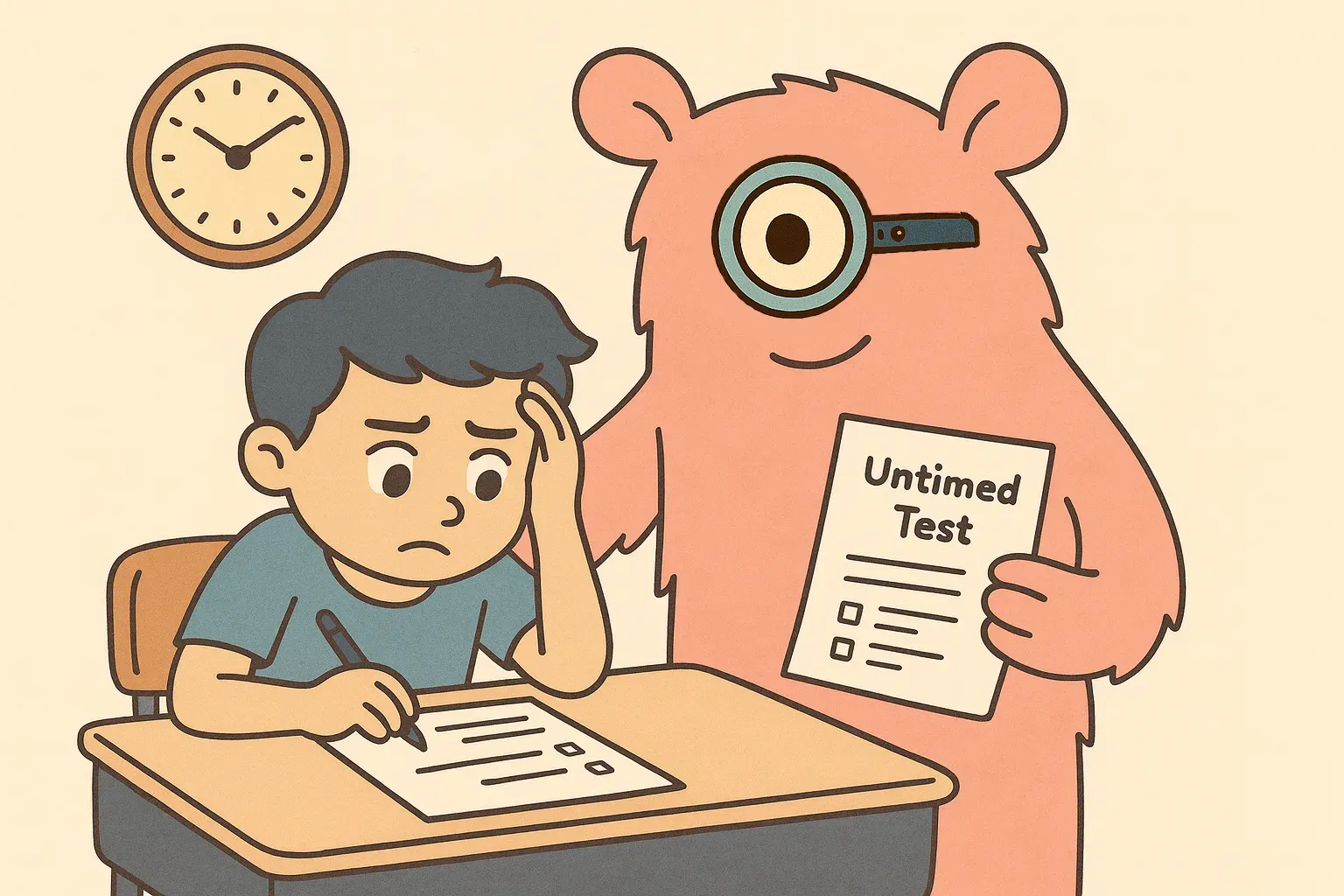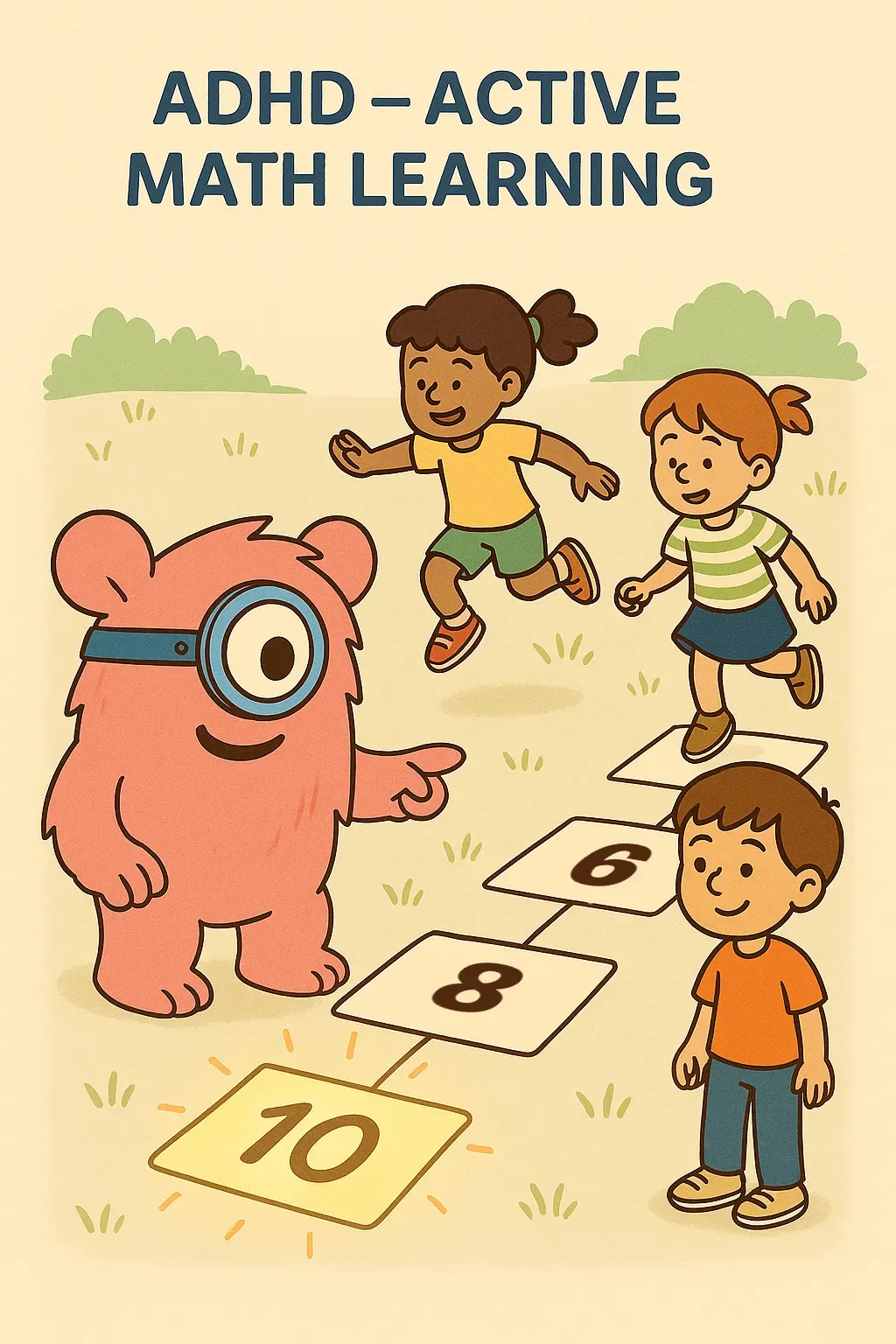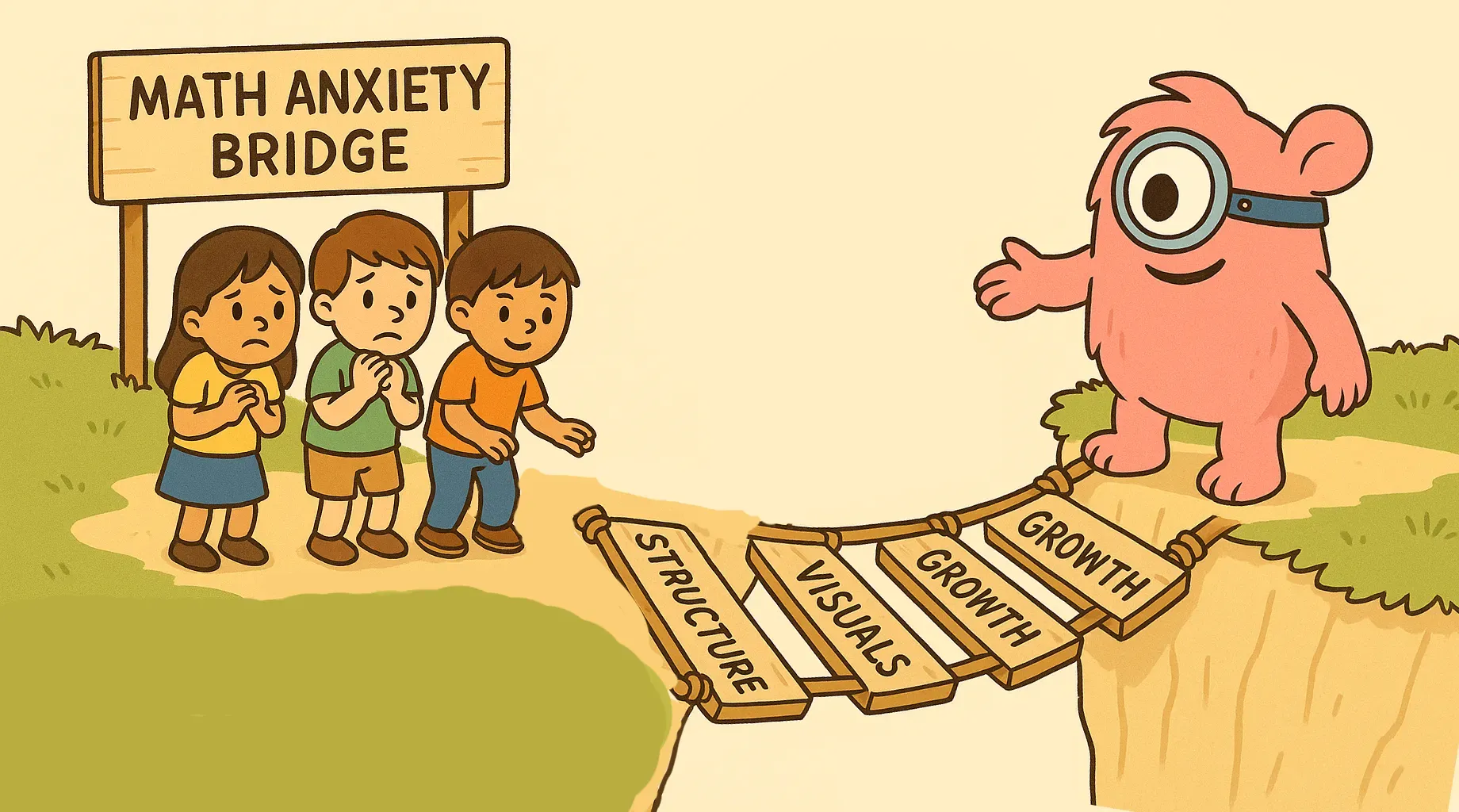Math Anxiety in Autism, ADHD, Dyscalculia - What’s Different & What Works
TL;DR: Math anxiety can affect any child, but kids with autism, ADHD, or dyscalculia often experience it in unique ways. Understanding these condition-specific patterns is key. For example, autistic children might not show higher overall math anxiety than their peers, yet can become extremely distressed by unexpected changes or time pressure in math. Children with ADHD may develop anxiety from repeated careless mistakes or focus struggles, leading to low confidence. Those with dyscalculia frequently face chronic failure in math, which can breed intense anxiety and learned helplessness. The good news is that targeted calming strategies – like using routine and visual aids for autism, game-based learning and confidence-building for ADHD, and supportive, step-by-step teaching for dyscalculia – can help each child overcome fear and even enjoy math. In all cases, celebrating small “math wins” (instead of timed drills) and fostering a growth mindset will steadily build their confidence and resilience.
Understanding Math Anxiety in Neurodivergent Kids
Math anxiety is an intense fear or stress response when dealing with math. It’s more common than many realize – one international study found that about 33% of 15-year-olds reported feeling helpless when solving math problems. For neurodivergent children (those with autism, ADHD, dyscalculia, etc.), math anxiety can be especially complex. Their brain differences mean they might experience and express anxiety in different ways. By exploring how math anxiety manifests in each condition – and what calming strategies work best – parents and teachers can better support these kids.
It’s important to note that math anxiety isn’t the same as simply being “bad at math.” In fact, many capable students suffer anxiety that holds them back despite strong ability. Likewise, a child could have a genuine math learning disability (like dyscalculia) without necessarily feeling anxious, or vice versa. In other words, math difficulties and math anxiety can occur independently. That said, anxiety and performance often influence each other. Repeated math struggles can make a child anxious, and that anxiety can in turn sabotage their performance, creating a vicious cycle – stress and anxiety can impair memory and learning. Neurodivergent kids are particularly at risk for this cycle, so understanding their needs is critical.
Math Anxiety in Autism Spectrum Disorder (ASD)
What’s different: Children on the autism spectrum often have uneven learning profiles – some excel in math, while others struggle with abstract concepts. Interestingly, research has found that high-functioning autistic students do not necessarily have higher math anxiety; one study even showed they had significantly lower math anxiety on average compared to their neurotypical peers. This might be because many autistic kids approach math as a logical, routine activity and sometimes find comfort in its structure. However, autistic learners can experience anxiety in specific math situations. A 2024 study revealed that autistic students felt comparable general (“trait”) math anxiety to other students, but they showed greater stress responses during actual math tasks under pressure (i.e. higher worry and emotional arousal). In that study, autistic boys performed worse on a timed math test and reported higher worry and physiological arousal than non-autistic peers when facing time pressure. In other words, an autistic child might seem calm about math in general yet still panic or shut down if a math quiz is rushed or if a problem is presented in an unexpected way.
Autistic children tend to thrive on predictability and clarity. Sudden changes in a math routine, unclear word problems, or sensory distractions in the classroom (like a noisy timed test) can spike their anxiety. They might express this as a meltdown, abrupt refusal (“I can’t do it!”), or withdrawal into silence. Unlike some anxious neurotypical kids who might simply say “I hate math,” an autistic child’s anxiety might show up as increased repetitive behaviors, distress at small mistakes, or fixation on getting the answer “perfect.” It’s also common for autistic students to have high general anxiety levels (many have co-occurring anxiety disorders), so math can become another trigger if not handled supportively.

What works: The key to calming math anxiety in autism is to create a low-stress, structured learning environment. Here are strategies that help:
- Provide structure and routine: Let your child know what to expect from math tasks. A predictable format (e.g. a warm-up, then a lesson, then practice problems) can reduce anxiety from uncertainty. Giving a heads-up about any changes in routine is crucial.
- Use visual supports: Many autistic kids are visual thinkers. Visual aids like number lines, diagrams, or color-coded steps can make math less intimidating and more concrete. Visual schedules or checklists for multi-step problems can also help them feel in control and reduce overwhelm.
- Avoid time pressure: Timed drills and surprise quizzes can be especially panic-inducing for autistic learners. Whenever possible, allow adequate time for them to process problems at their own pace. Research suggests that time pressure exacerbates anxiety and hurts performance in autistic students. Instead of timed tests, use untimed assessments or let them finish the last few problems at home if they need to.
- Incorporate interests and strengths: If the child has a special interest (trains, space, dinosaurs, etc.), try weaving that into math word problems or examples. Harnessing their passion can motivate them through anxiety. Likewise, if they excel at certain types of math (say, patterns or statistics), acknowledge those “math wins” to boost their confidence.
- Teach self-regulation skills: Even with support, an autistic child may get anxious when stuck on a tough problem. Prepare them with simple calming techniques. For example, practice “bubble breaths” (deep breathing) or have a sensory toolkit (stress ball, quiet corner) they can use when feeling overwhelmed. Our article on teaching emotional regulation during math tasks offers practical tips like naming feelings (“This problem makes me frustrated”) and taking “brain breaks” to reset.
Above all, respond to their math anxiety with patience and reassurance. An autistic child might not verbally express their worry, but you can notice signs (tensing up, fidgeting, avoiding the work) and gently coach them through it. For example, if they freeze up, you might say, “I see this problem is upsetting you. Let’s take a short break or try it a different way.” By showing empathy and flexibility, you help them feel safe – which is the first step to overcoming fear.
Math Anxiety in ADHD
What’s different: Kids with Attention-Deficit/Hyperactivity Disorder often face math challenges not due to lack of ability, but because of their symptoms: inattention, impulsivity, and executive functioning deficits. These challenges can indirectly fuel math anxiety. Imagine a student who keeps misreading signs or making “careless” errors on tests, or forgets the steps of a long division problem halfway through – over time, they may start to dread math class because it’s consistently frustrating. Research has highlighted a specific link between ADHD and math anxiety, with individuals who have ADHD traits being more likely to report high math anxiety levels. In one college study, students with a history of ADHD exhibited significantly higher anxiety specifically during math tasks than their peers, even after accounting for general anxiety levels. This suggests that something about the way ADHD affects learning (e.g. difficulty focusing or past negative math experiences) makes math a bigger anxiety trigger for these learners.
Children with ADHD might express math anxiety through avoidance (“I don’t want to do my math homework”), disruptive behavior, or rushing through work due to nervous energy. It’s easy for adults to misinterpret an ADHD child’s behavior – their restlessness or off-task chatting during a math test might actually be a cover for anxiety or a response to feeling overwhelmed. These kids also often struggle with low academic self-esteem. Studies find that students with more ADHD symptoms tend to have lower confidence in their academic abilities and more negative attitudes towards schoolwork. Over years, students with more ADHD symptoms tend to have lower confidence. Hearing “if you just tried harder you’d get it” or getting poor grades despite their intelligence, they may internalize the belief that they are “bad at math,” which heightens anxiety whenever they face math challenges.
What works: For children with ADHD, the goal is to make math engaging, manageable, and confidence-boosting. Here are effective strategies:
- Make math active and hands-on: Boredom and inattention are enemies of anxious ADHD brains. Incorporate movement and manipulatives into learning – for example, let them walk around while practicing math facts, use physical objects (blocks, cards) to work out problems, or turn math into a game. An interactive approach keeps their interest and leaves less room for anxious worrying. In fact, research shows that game-based math learning can improve confidence and reduce anxiety in students. A fun math app or a friendly competition on who can solve a puzzle (untimed) might make them forget they were ever anxious.
- Break tasks into smaller chunks: Long or multi-step problems can overwhelm kids with ADHD, triggering anxiety or shutdown. Teach them to tackle math one step at a time. You can cover the rest of the page with a paper and reveal one question at a time. Provide immediate feedback or encouragement after each chunk (“Great, you finished the first five problems!”) so they feel a sense of progress. This reduces the daunting feeling of “I’ll never get through all this.”
- Encourage “math wins” and minimize drills: Nothing builds confidence like success. Emphasize quality over quantity in practice – it’s better for an ADHD student to correctly solve five problems and feel proud, than to slog through 30 problems with growing frustration. Our “math wins, not drills” approach is especially powerful for anxious learners who need to rebuild trust in their abilities. Celebrate every improvement, no matter how small. Did they focus for 10 minutes straight today when usually it’s 5? That’s a win! Over time, these wins add up to real confidence.
- Teach with a growth mindset: Children with ADHD often get discouraged by setbacks, so explicitly countering the “I’m just bad at math” mindset is critical. Use positive language to reframe mistakes as learning opportunities. For instance, if they shout “I messed up again!”, you might respond, “Mistakes help us learn – let’s figure out where it went wrong.” Modeling this attitude yourself is key (avoid saying things like “I was never a math person” in front of them). You can also use simple phrases from growth mindset principles – our 7 growth-mindset math scripts for parents provide great examples, like praising effort (“I’m proud of how hard you worked on that problem”) or adding “yet” (“You don’t understand this yet, but you will!”). Over time, this shifts their perspective from fearing failure to embracing challenges.
- Offer accommodations and tools: Reducing anxiety sometimes means changing the environment. If allowed, let your child use scratch paper, graph paper, or a calculator for complex arithmetic so that working memory issues don’t derail them. In tests, request accommodations such as extra time or a quiet room if attention constraints make the standard setting stressful. These supports aren’t “crutches” – they’re like glasses for a child with vision issues, simply leveling the playing field so their true abilities (and knowledge) can shine without excess stress.
- Practice relaxation and focus techniques: Just as with autistic children, kids with ADHD benefit from learning how to calm their mind and body when anxiety spikes. Short mindfulness exercises (even 2-3 minutes) done regularly can improve their self-regulation. One simple technique is the “5-4-3-2-1” grounding exercise: ask them to find 5 things they can see, 4 they can touch, 3 they hear, 2 they smell, 1 they taste. It’s a quick way to center attention and ease nerves before tackling math. Physical movement can also help: a few jumping jacks or a quick dance break can burn off anxious energy and restart focus.

Parents should remember that an ADHD child’s anxious or off-task behavior during math isn’t willful misbehavior. Punishing them for getting distracted or rushing usually backfires – it increases their shame and anxiety. Instead, use positive reinforcement: “I noticed you really stuck with it for that whole problem, even though it was hard. Great job!” If the child is anxious about an upcoming math test, help them study in a calm, encouraging way rather than cramming with pressure. Consistent support and patience will, over time, prove to them that math doesn’t have to be a painful experience.
Math Anxiety in Dyscalculia
What’s different: Dyscalculia is a learning disability that impairs a child’s innate ability to understand numbers and math concepts. Understandably, many children with dyscalculia develop math anxiety after years of struggle – but the relationship isn’t as straightforward as it might seem. Research has found that about one in five children with developmental dyscalculia also has high math anxiety. That’s roughly double the rate of math anxiety in children without dyscalculia, indicating a strong overlap. However, it also means not every dyscalculic child is anxious (and indeed, many kids with severe math anxiety actually perform fine in math). In general, though, a child with dyscalculia is at high risk of feeling anxious about math simply because math has been a source of repeated failure and frustration for them.
Math anxiety in dyscalculia often stems from “learned helplessness.” By the time such a child is identified (often around 3rd or 4th grade), they may have internalized the belief that “I just can’t do math.” Imagine spending every math class confused while your classmates seem to get it – it’s a recipe for feeling defeated. These children might panic when seeing a worksheet full of calculations, or they might completely avoid homework, feeling it’s hopeless. Even if they study, their anxiety during tests can cause them to freeze up or forget methods they do know. One study noted that children with dyscalculia showed higher levels of math anxietyand weaker working memory and executive functions compared to their peers. Interestingly, for typical students in that study, having lower math anxiety predicted better calculation performance – but for dyscalculic students, reducing anxiety alone didn’t automatically improve math scores. That implies that their poor math performance is primarily due to the underlying disability, though the anxiety certainly adds an extra hurdle.
What works: Helping a child with dyscalculia overcome math anxiety requires a two-pronged approach: remediate the math difficulties so they start experiencing success, and simultaneously address the emotional side (the fear and self-doubt). Strategies include:
- Target the foundational skills: For dyscalculic learners, one of the best anxiety-reducers is actual improvement in math ability. They need specialized, patient instruction to rebuild number sense from the ground up. This might involve using concrete manipulatives (counters, abacus beads, visual models) to grasp basic concepts that others pick up intuitively. As they slowly gain competence in core skills like number comparison, simple addition/subtraction, etc., their fear will begin to lessen. Research supports this “deficit model” – poor math skills can lead to anxiety, so improving those skills can break the cycle. A math specialist or intervention program can make a huge difference for these kids.
- Emphasize progress, not perfection: Children with dyscalculia often compare themselves harshly to peers (“Everyone else knows this, why don’t I?”). It’s critical to shift the focus to their personal progress. Keep a record of “math wins” – for instance, “Last month you only knew 3 multiplication facts, and now you know 10!” Regularly show them evidence of growth. By celebrating small victories, you help rebuild their math self-esteem. Even if they are behind the class, seeing their own improvement (no matter how small) gives hope and motivation.
- Use supportive tools and accommodations: There is no shame in using tools to alleviate anxiety. Allow the child to use calculators or multiplication charts for complex arithmetic so that computational hurdles don’t derail them when the goal is understanding concepts. Graphic organizers can help set up word problems step-by-step. In exams, accommodations like extra time, partial credit for showing work, or even oral exams can prevent panic. These measures ensure the student’s dyscalculia doesn’t unnecessarily amplify their anxiety – they get to demonstrate learning in a way that’s accessible to them.
- Employ anxiety-reduction techniques: To specifically tackle the fear response, cognitive-behavioral techniques can be effective. Work on reframing negative thoughts: when your child says “I’ll never get this right,” have them practice a replacement like “I will get it if I keep trying or find a new strategy.” Some parents find it helpful to externalize the anxiety – e.g., give it a nickname like “Math Monster” and treat it as something the child can talk back to (“Go away, Math Monster, I’m trying my best!”). Teaching relaxation methods (deep breathing, visualization of a calm place) before math work can also take the edge off. If the anxiety is severe, short sessions with a school counselor or therapist who specializes in anxiety can provide the child with coping skills.
- Create a low-pressure practice environment: Outside of school, help your child practice math in a stress-free way. This could be through math-related games, apps, or everyday life activities (cooking, shopping) where math is embedded but the focus is on fun or real-life usefulness. By experiencing math without the high stakes, they can start to see it as less scary. The aim is to replace some of those bad associations (tests, timed drills, getting things wrong) with positive ones (playing a cool math game, successfully helping measure ingredients for a recipe, etc.). Over time, this retrains their emotional response to math triggers.
- Consider 1-1 coaching if it's financially viable: Because group settings can sometimes heighten anxiety, parents may find that individualized tutoring helps children progress at their own pace, without the added stress of competition or time pressure. This can be especially helpful when addressing challenges of how to learn math with ADHD.
One reassuring finding from research is that math anxiety and actual math disability don’t always go hand-in-hand. This means if we address each problem separately – help the child improve their skills and help them manage their anxiety – they can escape the cycle. Experts emphasize treating the “emotional blocks” and “cognitive blocks” in parallel. In practice, that might look like a combination of tutoring (to target the dyscalculia directly) and counseling or at-home anxiety interventions (to build confidence and coping). With time and the right support, even a child with serious dyscalculia can learn to handle math without debilitating fear. They may never love math, and that’s okay – the goal is for them to navigate necessary math in life with self-assurance rather than avoidance. Every child deserves to feel, “I can do this,” no matter how hard it is.
Bringing It All Together: Helping Your Child Thrive

While the causes of math anxiety may differ for autism, ADHD, and dyscalculia, there are common threads to what helps. All children – neurodivergent or not – benefit from patience, encouragement, and understanding that mistakes are part of learning. Create a home environment where math is not a source of judgment or punishment. Instead of saying “Why can’t you get this?,” try “Let’s figure this out together.”
Model a calm attitude: if you (the parent) openly dislike math or get anxious balancing the checkbook, your child can absorb those feelings. Show them that math can be approached with curiosity and even humor. For instance, do a silly estimation game while driving (“How many blue cars will we see in 5 minutes?”) to lighten the mood around numbers.
Also, maintain open communication with your child’s teachers. If you know your child has special needs – whether it’s an IEP for dyscalculia or an accommodation for ADHD – ensure the school is implementing supports consistently. A compassionate teacher who understands your child’s triggers (be it bright lights, or requiring movement, or needing untimed tests) can dramatically reduce classroom anxiety. Work together on a plan: perhaps the autistic student can quietly signal when they need a break, or the ADHD student can stand at the back of the room to work when feeling restless. These little adjustments prevent anxiety from boiling over.
Finally, consider that improving math anxiety takes time. It’s not a quick fix, but gradual change is very possible. Keep expectations realistic – you might measure progress in months or semesters rather than days. But each step, each smile or confident moment your child has with math, is building a healthier relationship. The ultimate aim isn’t to turn every child into a mathematician; it’s to ensure that anxiety no longer stands in the way of them learning what they need to learn. By understanding your child’s unique profile (autism, ADHD, dyscalculia, or any combination) and tailoring your approach with proven strategies, you are giving them the tools to succeed not just in math class, but in any challenge that comes their way. With support, our neurodivergent learners can transform math from a source of fear into an opportunity for growth.
FAQs
Q: How can I tell if my child’s math anxiety is related to a condition like dyscalculia or ADHD?
A: Look at the bigger picture of your child’s learning. If your child has significant, persistent trouble with basic math (like recognizing quantities, arithmetic facts, etc.) from early on, and their anxiety seems to stem from constantly “not getting it,” dyscalculia could be a factor. In dyscalculia, the anxiety usually comes after repeated failures – the child feels helpless because the math itself is very hard for them. On the other hand, if your child is capable in math conceptually but struggles to stay focused, rushes through work, or makes careless mistakes (common with ADHD), their anxiety might be more about performance issues or school pressure. An ADHD-related math anxiety might show up as the child being very nervous before tests or upset that they make “silly” errors. Kids on the autism spectrum might not appear anxious about math until something triggers them (like a confusingly worded problem or a timed exercise). In all cases, if math anxiety is significant, it’s wise to have an evaluation done. A psychoeducational assessment can identify dyscalculia or other learning differences. Knowing the root cause will help tailor the support – for example, dyscalculia might require intensive remediation, whereas ADHD-related anxiety might be eased with test accommodations and study strategies.
Q: What are some quick calming strategies I can use when my child panics over math homework?
A: First, pause the math. Anxiety can put a child in “fight or flight” mode, where learning isn’t possible. Have a go-to calming routine: deep breathing together (try “belly breathing” with a plush toy on their tummy to slow each breath), a short stretch or walk, or even a 5-minute break to get a drink of water. Once they’re a bit calmer, acknowledge their feelings – “I see you’re really worried about this.” Sometimes just feeling heard helps the anxiety subside. Then, help them break the task down. For example, cover up all but the first problem, or do one example together out loud. Remind them that it’s okay not to know immediately – say “We can figure it out step by step.” Positive reinforcement is big here: celebrate when they complete a part of the work (“Great, you solved that one, and it was tough!”). Another handy tip is to switch modalities: if writing is freaking them out, try using magnetic number tiles or drawing the problem on a whiteboard – a change in format can reduce pressure. Lastly, keep your own tone calm and encouraging; if you stay composed, it signals to your child that there’s no emergency – this is just a problem to solve, not a crisis.
Q: My child is neurodivergent and absolutely hates timed math tests. What can I do?
A: Timed tests are a very common anxiety trigger, especially for neurodivergent students. If your child has an identified condition like ADHD, autism, or an anxiety disorder, you should discuss accommodations with their teacher or school. Many schools will allow untimed or extended-time tests for students who need it. Share the reasons with the teacher – for instance, you might explain, “When my child is timed, their anxiety spikes and it doesn’t actually reflect their math knowledge.” There’s strong evidence that timed tests can induce math anxietyeven in high-achieving students, so educators are often understanding about this. If formal accommodations aren’t an option, you could try some workarounds: practice similar problems at home untimed to build confidence (so the child feels more prepared), or have the child do relaxation exercises right before the test (deep breaths, positive self-talk like “I’ve got this”). Also, encourage them to focus on accuracy over speed – sometimes telling a child “it’s okay if you don’t finish all questions, just do the ones you can” takes off huge pressure. Over time, as their anxiety lessens, they may naturally get faster. But the priority is to ensure they don’t develop a long-term phobia of math because of these drills. If needed, be your child’s advocate – it might involve a meeting with school staff to find a better way to assess math skills that doesn’t terrorize your child. Many teachers will accommodate once they realize how harmful timed tests can be for some kids.
Q: Can focusing on a growth mindset really help reduce math anxiety?
A: Absolutely. A lot of math anxiety comes from a fixed mindset – the belief that “I’m just not a math person” or that a mistake is a permanent failure. By cultivating a growth mindset, you chip away at those beliefs. When a child truly understands that ability grows with effort and that mistakes are learning opportunities, math loses its scary finality. Research by psychologist Carol Dweck and others has shown that students who develop a growth mindset tend to be more resilient and less anxious when facing academic challenges. For example, if a child with anxiety gets a poor math grade, a fixed mindset might make them think “I’ll never get better, this is proof I’m dumb at math,” whereas a growth mindset reframes it as “I didn’t do well yet; I can improve if I figure out what I didn’t understand.” Parents can foster this by praising effort (“You worked really hard on that”), strategy (“I like how you tried a different way to solve it”), and progress rather than just correct answers. Sharing stories of famous scientists or mathematicians who struggled and learned from failure can also inspire them. In our Growth-Mindset Math Scripts article, we give concrete examples of phrases that reinforce this outlook. Over time, these messages sink in. The child starts approaching math with less fear because they know getting it wrong isn’t the end of the world – it’s just a step toward getting it right. This doesn’t magically erase anxiety overnight, but it builds a protective layer of confidence and resilience that makes a huge difference.
Q: What if my child’s math anxiety doesn’t improve – could it become a long-term problem?
A: If left unaddressed, math anxiety can indeed persist into high school, college, and even adulthood. It can influence the courses students choose (some may avoid advanced math classes or STEM careers because of it). That’s why it’s great you’re being proactive now. The earlier we tackle it, the better the outcome. Most children, with the right support, do make significant improvements. They might not go from math-phobic to math-whiz, but they can learn to handle math with less distress. If you’ve been consistently trying strategies for a while and see little progress, it might be time to seek additional help. A therapist or counselor who specializes in childhood anxiety (or educational psychology) can work with your child on deeper strategies, like exposure therapy (gradually facing math fears in a controlled way) or cognitive-behavioral therapy (to reframe negative thoughts). Also, consider a reevaluation for any unnoticed learning issues – sometimes undiagnosed dyslexia or ADHD, for example, can indirectly contribute to math anxiety. Don’t lose hope: even many adults who were once “math anxious kids” have overcome it through a combination of determination and finding new ways to engage with math (like through practical applications or supportive mentors). By acknowledging the problem and continuously showing your child that you’re in their corner, you’re already preventing it from becoming a lifelong barrier. Keep celebrating the small victories, and remember that progress in managing anxiety is often nonlinear – they might have ups and downs, but the overall trend will be improvement with patience and support.
References
- Ramirez, G., et al. (2018). Analysis of international data on math anxiety (PISA 2012). Frontiers in Education, 3:798516. https://doi.org/10.3389/feduc.2022.798516
- Georgiou, A., et al. (2018). Math Anxiety of Students with High Functioning Autism Spectrum Disorder. American International Journal of Social Science, 7(4). Full text PDF
- Lievore, R., & Mammarella, I.C. (2024). Trait and state mathematics anxiety in autistic and non-autistic school-aged boys. Autism, 29(5), 1209-1223. PMCID: PMC12038072
- Lievore, R., Caviola, S., & Mammarella, I.C. (2025). Children with and without dyscalculia: How mathematics anxiety and executive functions may (or may not) affect mental calculation. Learning and Individual Differences, 121, 102693. https://doi.org/10.1016/j.lindif.2025.102693
- Devine, A., et al. (2018). Prevalence of Developmental Dyscalculia and Mathematics Anxiety. Journal of Educational Psychology, 110(3), 431–444. Full text PDF
- Canu, W.H., Elizondo, M., & Broman-Fulks, J.J. (2017). History of ADHD traits related to general test and specific math anxiety in college students. Learning and Individual Differences, 58, 56-63. https://www.sciencedirect.com/science/article/abs/pii/S1041608017301425
- Hung, C.M., Huang, I., & Hwang, G. (2014). Effects of digital game-based learning on students’ self-efficacy, motivation, anxiety, and achievements in mathematics. Journal of Computers in Education, 1(2-3), 151–166. https://doi.org/10.1007/s40692-014-0008-8
- Kim, E.J., Pellman, B., & Kim, J.J. (2015). Stress effects on the hippocampus: a critical review. Learning & Memory, 22(9), 411–416. https://learnmem.cshlp.org/content/22/9/411.full.pdf

